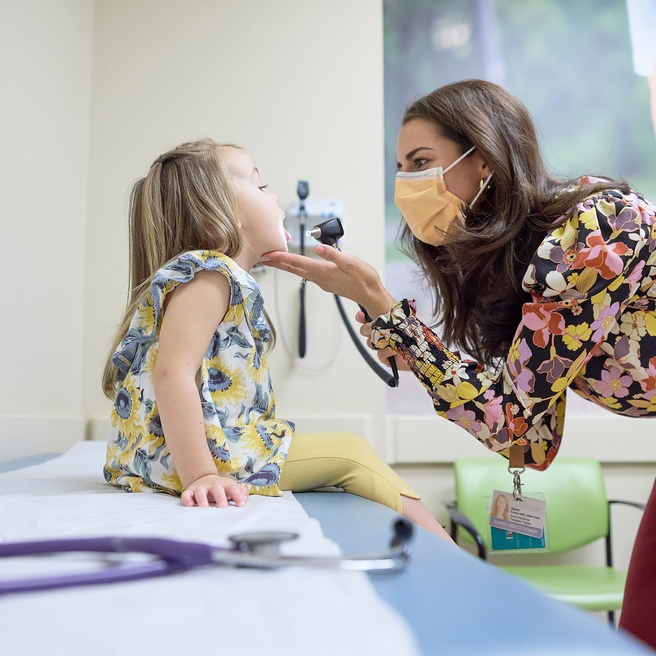What is VACTERL Association?
VACTERL association, sometimes called VATER syndrome, is a group of conditions that occur together. The name is based on an acronym for the affected organs and systems:
V — the vertebrae (bones of the spinal column)
A —anus
C —cardiac anomalies
T— trachea
E— esophagus (the tube food enters when you swallow)
R —renal (kidney) anomalies
L —limb differences
VACTERL association presents differently in each affected person — not all patients will experience the same combination of symptoms — or the same degree of severity of symptoms. To be diagnosed with VACTERL, a baby must have anomalies in at least three of these symptoms.
It’s estimated that 1 out of 10,000 to 40,000 babies is born with VACTERL. Because the condition presents in different ways and diagnostic criteria vary, it’s likely the condition is somewhat underdiagnosed.
Boys are slightly more likely than girls to be affected, but VACTERL isn’t more common among any particular ethnic or racial group. Having one baby with VACTERL doesn’t increase your chances of having another baby with the disorder.
Causes of VACTERL Association
We don’t yet fully understand what causes VACTERL as it affects the development of multiple body systems and takes place early in pregnancy. Scientists suspect it’s caused by a combination of genetic and environmental factors. There is also some evidence that women who have diabetes may be more likely to have babies with VACTERL.
Signs and symptoms of VACTERL Association
Indications of VACTERL are varied and affect many different parts of the body — not all patients will exhibit all of them. Following are some of the most common symptoms.
Vertebral anomalies
As many as 80% of people with VACTERL have defects or anomalies in the bones of their spine, sometimes also involving the ribs. These can include missing or extra bones, extra ribs, fused bones, abnormally shaped bones or curvature of the spine, known as scoliosis.
Anal anomalies
The majority of people with VACTERL association have an abnormal anus, including anal atresia (also called imperforate anus) which means the opening of the anus is missing or blocked. Signs of anal atresia include a bloated abdomen, vomiting, and a lack of (or light and irregular) bowel movements.
Cardiac anomalies
Roughly half of the children with VACTERL association will have some abnormalities of the heart. These can take many forms, but the most common are:
- Atrial septal defect — a hole in the wall between the two upper chambers of the heart
- Hypoplastic left heart syndrome (HLHS) —a malformation of the left side of the heart which prevents blood from flowing normally through the heart
- Patent ductus arteriosus (PDA) — an abnormal opening in a blood vessel in the heart keeps blood from traveling to the lungs for oxygenation
- Tetralogy of Fallot — a combination of four heart defects that affect the aortic valve, pulmonary valve and right ventricle
- Transposition of the great arteries —two of the heart’s main arteries are backward
- Ventricular septal defect (VSD) — a hole in the wall that divides the right and left lower chambers of the heart (ventricles)
Signs that a child has heart anomalies can include shortness of breath or difficulty breathing, fatigue, blue skin color, an abnormal heart rhythm, heart murmur, fast pulse and failure to gain weight/poor appetite.
Trachea and esophageal anomalies
The trachea is more commonly called your windpipe; the esophagus is the tube that food enters when you swallow. Normally, these tubes are not connected in any way, but for children with VACTERL association, they are often attached to each other through a fistula (essentially a hole or passage between the two tubes) which allows food to enter the airway.
Youth with VACTERL association may have other abnormalities, such as esophageal atresia, which means the esophagus ends in a pouch and doesn’t properly connect to the stomach.
Signs of tracheal-esophageal involvement include difficulty swallowing (including coughing or choking while eating), aspirating food into the lungs, blue color, poor appetite and weight gain, swollen abdomen and vomiting.
Renal anomalies
About half of all individuals with VACTERL association have issues with their kidneys. These can take many forms including a missing or malformed kidney, kidneys out of place in the body and blocked urine flow. For boys, they may also have hypospadias, where the urethral opening is on the bottom of the penis instead of the tip. Children with any of these symptoms are more prone to urinary tract infections.
Limb differences
Many children with VACTERL association have limb differences including extra fingers or toes, webbed fingers or toes, missing or underdeveloped thumbs and underdeveloped forearms.
Other symptoms
Some other more general symptoms of VACTERL association include facial asymmetry, slow growth and abnormally shaped ears.
Testing and diagnosis for VACTERL association
There is no one test for VACTERL association, also known as VATER syndrome. Instead, it’s considered a “diagnosis of exclusion.” That means that when other causes of the birth defects have been ruled out, the remaining diagnosis is VACTERL association. To rule out other causes with similar symptoms, doctors will visually assess the patient and run a series of tests, including genetics.
A child must have at least three affected systems out of the seven mentioned above to be diagnosed with VACTERL.
Your child's appointment
Learn what to bring, what to expect when you arrive and during your child's examination, and how to schedule follow-up testing.
Treatment for VACTERL association
Because the symptoms of VACTERL association are so varied, the treatments are as well. The most suitable treatments depend on what kind of symptoms the child has and how severe they are. Most patients can be treated with a combination of surgeries, medications, and physical or occupational therapies.
Surgical solutions are most common for children with “structural” symptoms such as anal atresia, esophageal fistula or atresia, cardiac issues and vertebral anomalies. Some of these procedures may need to be done shortly after the child is born; while others are treated after symptoms emerge. Supportive care such as physical therapy can be helpful in managing or reducing some symptoms or side effects of the disorder.
Long term outlook for VACTERL association
Fortunately, the symptoms associated with VACTERL generally aren’t life-threatening and can be successfully treated, although some children may need multiple surgeries to achieve full function. Depending on their specific symptoms, children with VACTERL may need ongoing supportive care and to be monitored by one or more specialties, including gastroenterology, urology, cardiology and orthopedics.
The long-term outlook for children with VACTERL association – who have received treatment as needed for their specific symptoms – is generally good and most experience typical intellectual development. However, some children with VACTERL may be more prone to chronic health problems into adulthood. The good news is that with the right supportive care, patients with VACTERL can lead happy, productive lives.
Why choose CHOP for VACTERL association?
For complicated conditions that affect multiple body systems like VACTERL, a team of specialists working together is the most effective way to ensure the child achieves their optimal health. Children’s Hospital of Philadelphia has the resources to provide world-class care within each of the specialties that children with VACTERL need, and can provide coordinated care, treatment and monitoring.
Our specialist teams can also help provide the patient and family with education to help them better understand their child’s diagnosis and create an individualized treatment plan to reduce symptoms, coordinate ongoing care and support patients as they live their lives.
Resources to help
Suzi and Scott Lustgarten Center for GI Motility Resources
We have provided GI motility resources to help you find answers to your questions and feel confident with the care you are providing your child.

